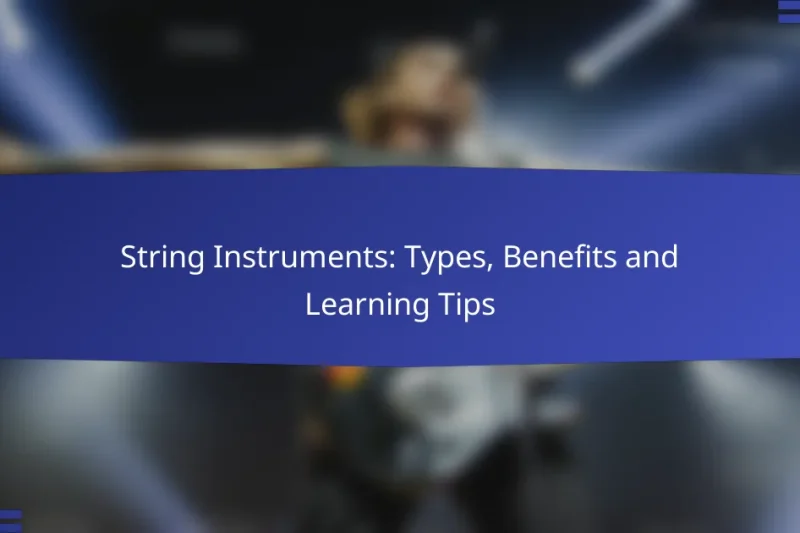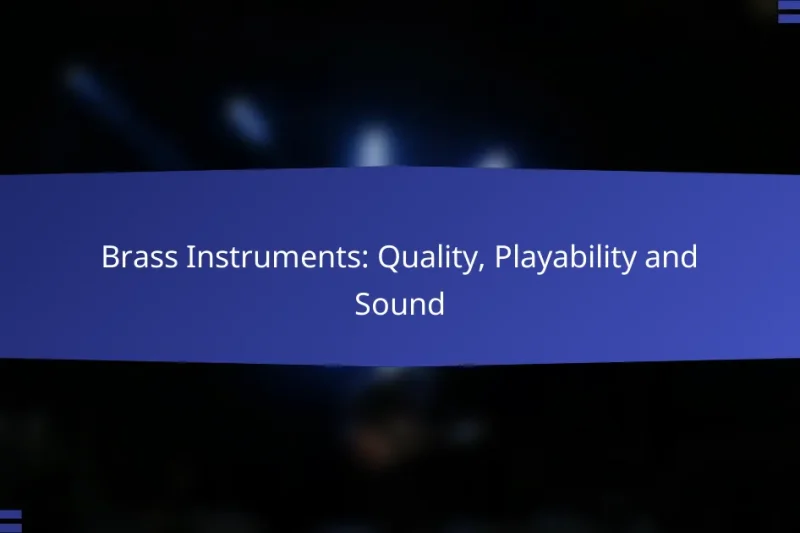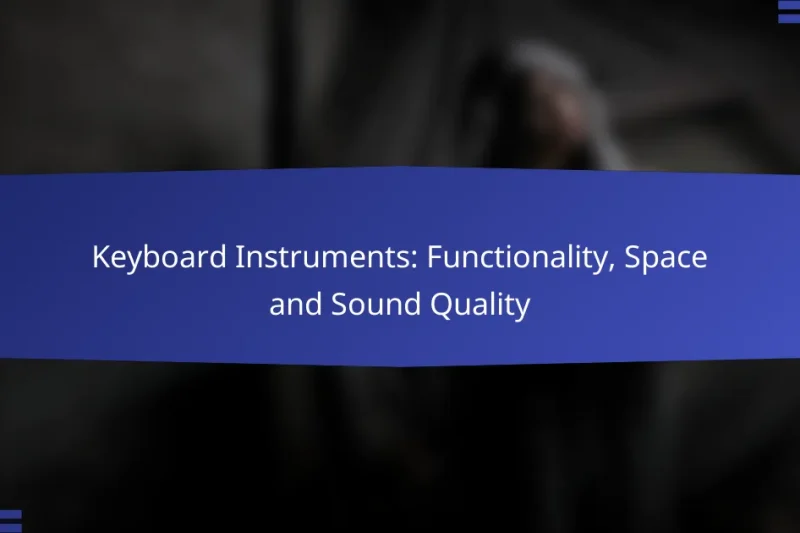String instruments encompass a diverse range of types, such as violins, guitars, and cellos, each with … String Instruments: Types, Benefits and Learning TipsRead more
Musical Instruments Types
Musical instruments can be broadly classified into five main categories: string, wind, percussion, electronic, and keyboard instruments. Each type offers distinct characteristics and techniques that cater to various musical styles and preferences. Selecting the right instrument as a beginner involves evaluating your interests, skill level, and budget, ensuring a fulfilling musical journey.
Brass Instruments: Quality, Playability and Sound
Brass instruments, such as the Bb trumpet and student trombone, are ideal for beginners due to … Brass Instruments: Quality, Playability and SoundRead more
Folk Instruments: Cultural Significance, Types and Learning Resources
Folk instruments play a vital role in preserving cultural heritage and expressing the unique identities of … Folk Instruments: Cultural Significance, Types and Learning ResourcesRead more
Keyboard Instruments: Functionality, Space and Sound Quality
Choosing the right keyboard instrument for home use involves balancing functionality, sound quality, and space considerations. … Keyboard Instruments: Functionality, Space and Sound QualityRead more
Acoustic vs Electric Guitars: Which Is Better and When to Use
When deciding between acoustic and electric guitars, it’s essential to consider your musical goals and preferences. … Acoustic vs Electric Guitars: Which Is Better and When to UseRead more
What are the most popular types of musical instruments?
The most popular types of musical instruments can be categorized into five main groups: string, wind, percussion, electronic, and keyboard instruments. Each category has its unique characteristics and playing techniques that appeal to different musicians and genres.
String instruments
String instruments produce sound through vibrating strings, which can be plucked, bowed, or struck. Common examples include the violin, guitar, and cello. The choice of material and string tension can greatly affect the instrument’s tone and playability.
When selecting a string instrument, consider factors such as size, weight, and the type of music you wish to play. Beginners often start with instruments like the acoustic guitar or violin due to their versatility and availability of learning resources.
Wind instruments
Wind instruments generate sound by the vibration of air within them, typically through the use of a reed or by blowing across an opening. Popular examples include the flute, clarinet, and trumpet. Each wind instrument has a distinct sound and requires specific breath control techniques.
For those interested in wind instruments, it’s essential to consider the instrument’s range and the level of skill required. Instruments like the recorder are often recommended for beginners due to their simplicity and ease of learning.
Percussion instruments
Percussion instruments create sound by being struck, shaken, or scraped. This category includes drums, tambourines, and marimbas. Percussion instruments are crucial for rhythm and can be found in nearly every musical genre.
When choosing a percussion instrument, consider the type of music you want to play and whether you prefer handheld or larger instruments. Drums, for example, come in various sizes and styles, from snare drums to full drum kits, each offering different sounds and playing experiences.
Electronic instruments
Electronic instruments use electronic circuitry to generate sound, often allowing for a wide range of tones and effects. Key examples include synthesizers, electric guitars, and drum machines. These instruments have transformed modern music production and performance.
For musicians interested in electronic instruments, understanding the basics of sound synthesis and effects processing is beneficial. Many electronic instruments offer extensive customization options, enabling users to create unique sounds tailored to their musical style.
Keyboard instruments
Keyboard instruments produce sound through a series of keys that control hammers, strings, or electronic sound generators. Common types include pianos, organs, and synthesizers. They are versatile and suitable for various musical genres, from classical to contemporary pop.
When selecting a keyboard instrument, consider the number of keys, touch sensitivity, and additional features like built-in sounds or recording capabilities. Digital pianos are popular among beginners for their realistic feel and portability compared to traditional acoustic pianos.
How to choose the right musical instrument for beginners?
Choosing the right musical instrument as a beginner involves considering your skill level, musical interests, and budget. These factors will help you select an instrument that is enjoyable and suitable for your personal growth in music.
Consider skill level
Your current skill level is crucial in selecting an instrument. Beginners may want to start with instruments that are easier to learn, such as the ukulele or keyboard, while those with some experience might opt for more complex instruments like the guitar or violin.
It’s also important to think about the learning curve associated with each instrument. Instruments like the recorder or harmonica can be played relatively quickly, while others may require more time and practice to master.
Evaluate musical interests
Your musical interests should heavily influence your choice of instrument. If you enjoy pop music, a guitar or keyboard might be ideal, while those interested in classical music may prefer the piano or violin.
Consider the genres you are passionate about and how different instruments fit into those styles. Listening to various types of music can help clarify which instrument resonates with you the most.
Assess budget
Budget is a significant factor when choosing a musical instrument. Beginners can find quality instruments in the range of $100 to $500, depending on the type and brand. It’s wise to set a budget before shopping to narrow down your options.
Additionally, consider ongoing costs such as maintenance, accessories, and lessons. Some instruments may require more investment in these areas, so factor that into your overall budget to avoid surprises later on.
What are the benefits of learning a musical instrument?
Learning a musical instrument offers numerous benefits, including cognitive development, enhanced creativity, and improved social skills. These advantages can significantly impact personal growth and overall well-being.
Improves cognitive skills
Playing a musical instrument engages various areas of the brain, enhancing cognitive functions such as memory, attention, and problem-solving skills. Studies suggest that musicians often perform better in tasks requiring multitasking and critical thinking.
For instance, learning to read music and coordinate hand movements simultaneously can sharpen mental agility. Regular practice can lead to noticeable improvements in academic performance, particularly in subjects like mathematics and languages.
Enhances creativity
Learning an instrument fosters creativity by encouraging self-expression and exploration of musical ideas. Musicians often experiment with different sounds, styles, and compositions, which can translate into innovative thinking in other areas of life.
Engaging with music allows individuals to develop their unique artistic voice, whether through improvisation or songwriting. This creative outlet can boost confidence and inspire new ways of thinking.
Boosts social interaction
Playing a musical instrument can enhance social skills by providing opportunities for collaboration and communication. Joining bands, orchestras, or music groups encourages teamwork and helps build relationships with others who share similar interests.
Participating in musical activities can also lead to increased social engagement, as musicians often perform at events or gatherings. This interaction can improve interpersonal skills and create lasting friendships.
What are the differences between acoustic and electric instruments?
Acoustic instruments produce sound naturally through physical vibrations, while electric instruments rely on electronic amplification. The choice between them often depends on the desired sound, performance context, and personal preference.
Sound production methods
Acoustic instruments generate sound through methods such as vibrating strings, air columns, or membranes. For example, a guitar creates sound when its strings vibrate, while a flute produces sound by directing air across an opening. In contrast, electric instruments use pickups and amplifiers to convert vibrations into electrical signals, which are then amplified to produce sound.
This fundamental difference affects the tonal quality and volume. Acoustic instruments typically have a warm, rich sound, while electric instruments can offer a wider range of tones and effects through electronic manipulation.
Portability and usage
Acoustic instruments are often more portable since they do not require external power sources or amplification equipment. Instruments like ukuleles or small acoustic guitars can be easily carried to various locations for casual playing. Electric instruments, however, may require additional gear such as amplifiers and cables, making them less convenient for spontaneous performances.
In performance settings, acoustic instruments are well-suited for intimate venues, while electric instruments excel in larger spaces where amplification is necessary. Musicians should consider the environment when choosing between the two types.
Price range
The price of acoustic instruments generally varies from affordable models in the low hundreds to high-end pieces that can cost thousands of dollars. For instance, a basic acoustic guitar may start around $100, while professional models can exceed $3,000.
Electric instruments also range widely in price, with entry-level guitars starting around $200 and premium models reaching several thousand dollars. Additionally, the cost of amplifiers and effects pedals can add significantly to the overall investment in electric instruments, so budgeting should account for these extras.
What are the best brands for musical instruments?
The best brands for musical instruments are recognized for their quality, reliability, and innovation. Brands like Yamaha, Gibson, and Roland have established themselves as leaders in their respective categories, offering a range of products that cater to musicians of all levels.
Yamaha for keyboards
Yamaha is renowned for its keyboards, offering a variety of models suitable for beginners to professionals. Their digital pianos and synthesizers are known for their realistic sound and user-friendly interfaces, making them a popular choice among musicians.
When selecting a Yamaha keyboard, consider factors such as the number of keys, weighted action, and built-in features like recording capabilities. Models like the Yamaha P-Series are excellent for portability and performance, while the Clavinova series offers premium sound quality for home use.
Gibson for guitars
Gibson is a prestigious brand in the guitar world, famous for its electric and acoustic guitars. Their instruments are celebrated for their craftsmanship and distinctive sound, making them a favorite among many professional musicians.
When choosing a Gibson guitar, pay attention to the model type, such as the Les Paul or SG, as each offers unique tonal characteristics. Consider your playing style and genre to find the best fit, and be aware that Gibson guitars typically come at a higher price point, reflecting their quality and heritage.
Roland for electronic instruments
Roland is a leading brand for electronic instruments, including synthesizers, drum machines, and digital pianos. Their products are known for innovative technology and versatility, appealing to both live performers and studio musicians.
When selecting a Roland electronic instrument, evaluate the features that matter most to you, such as sound engine quality, connectivity options, and portability. Models like the Roland TR-8S drum machine and the JUPITER-X synthesizer are popular for their robust capabilities and user-friendly design.




